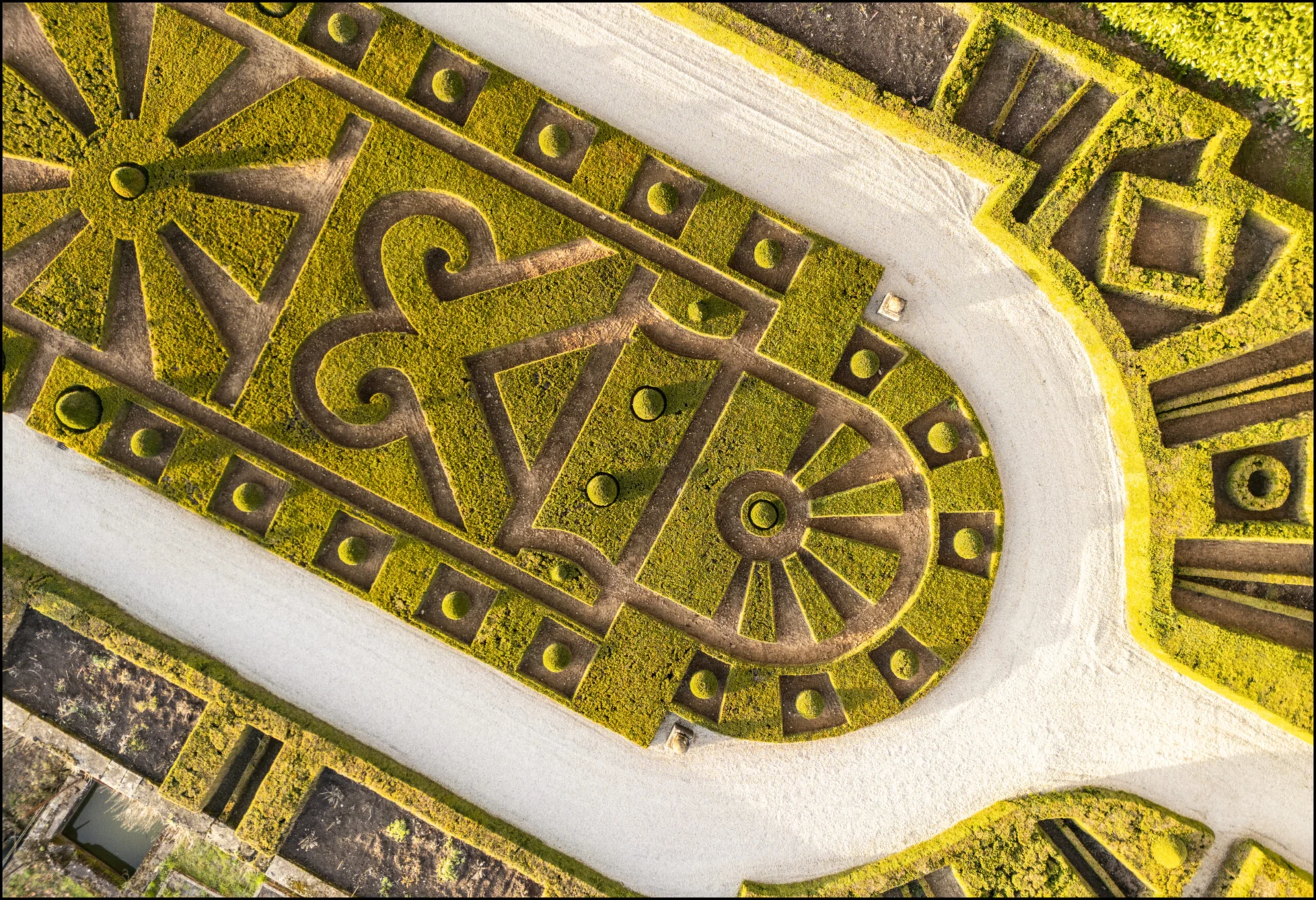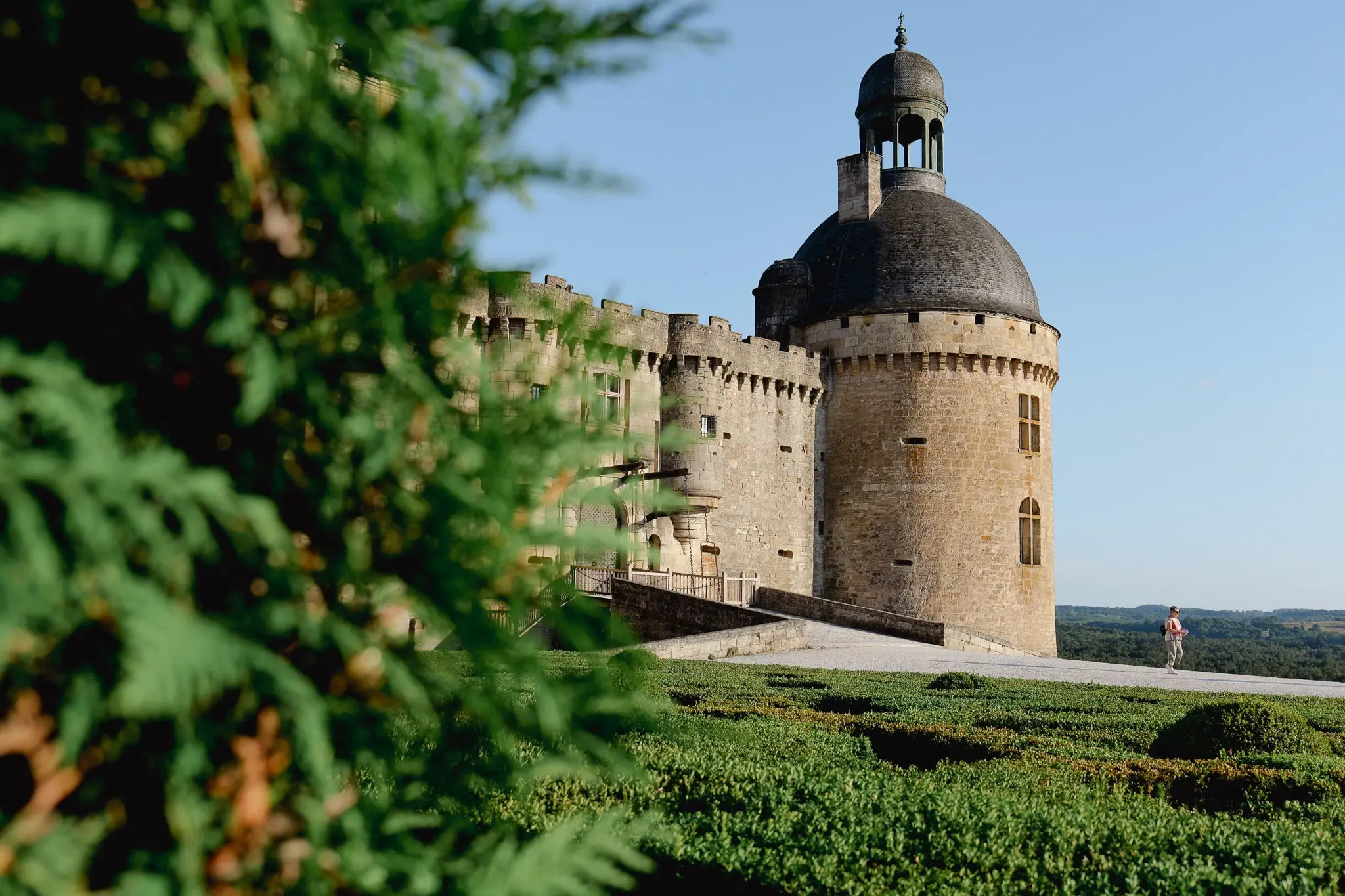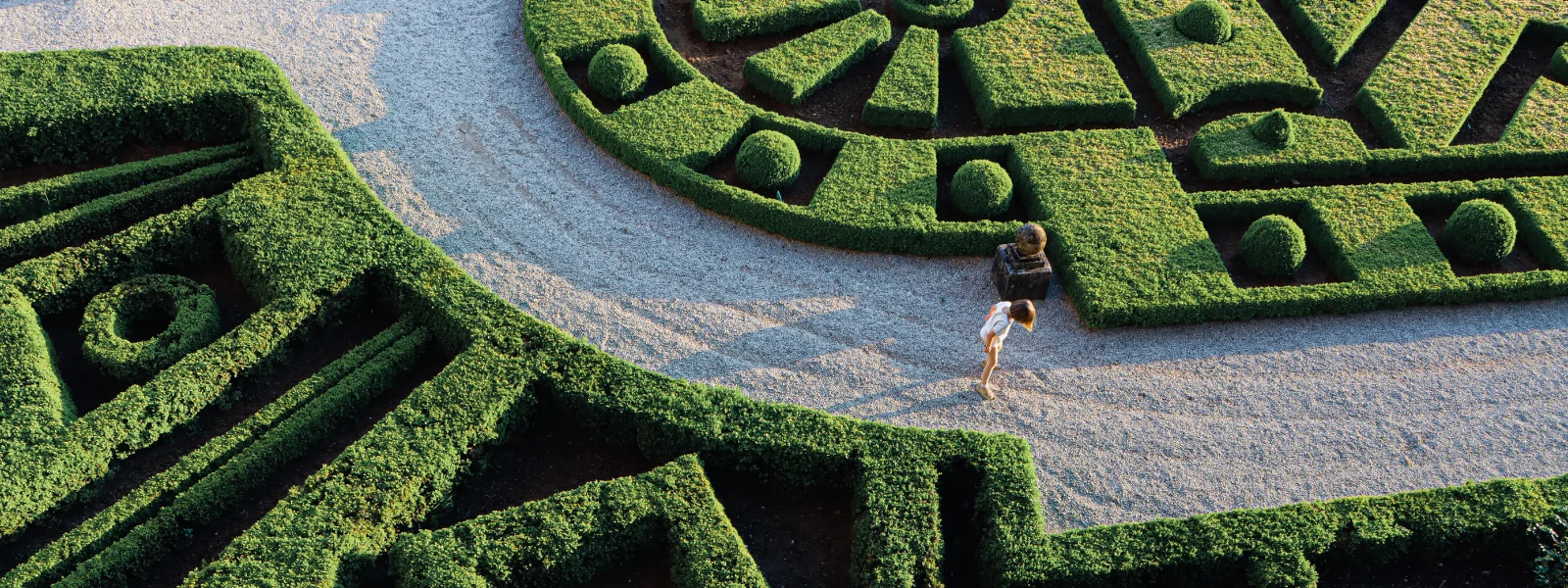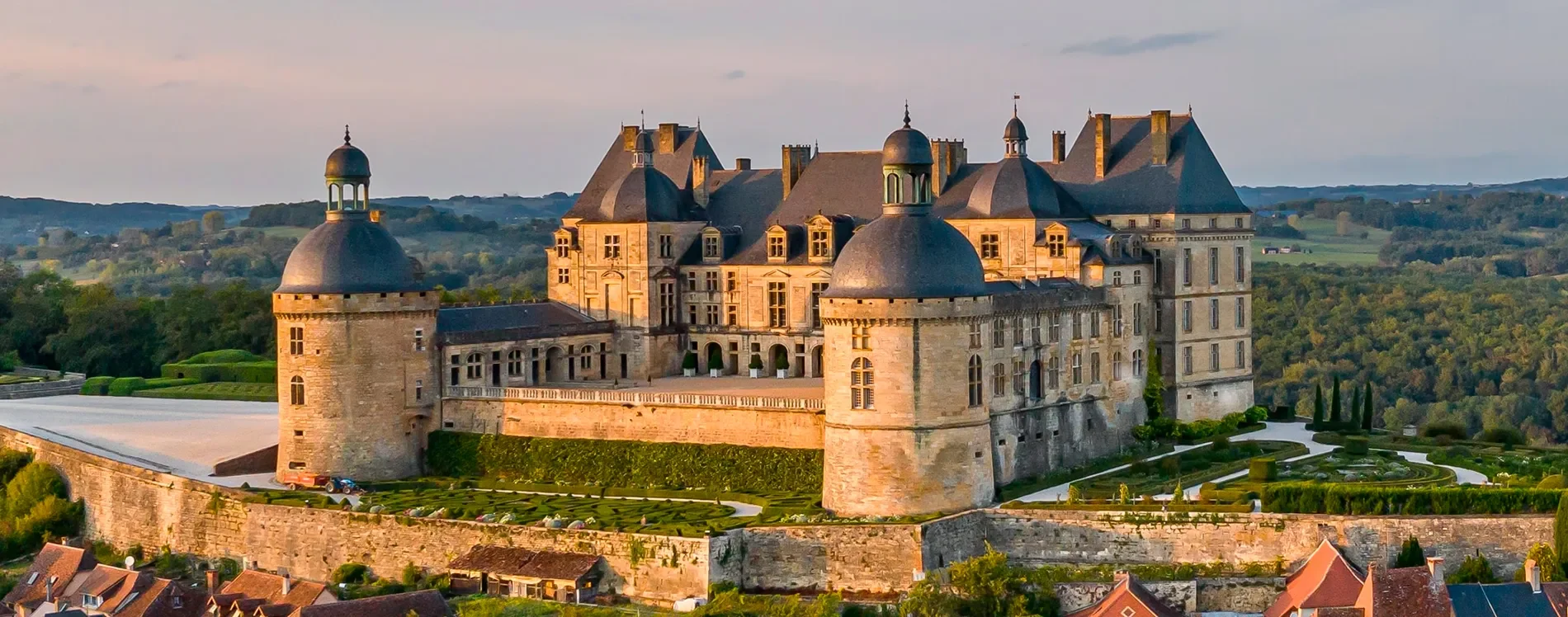Les Jardins à la Française: A Symphony of Order and Beauty
French gardens are a dazzling symbol of the elegance and grandeur of French landscaping, embodying an aesthetic vision in which nature is tamed and magnified by the hand of man.
First introduced under the reign of Louis XIV, this form of gardening reached its apogee with André Le Nôtre, the gardener of Versailles. These gardens are not just green spaces, but veritable works of art in which every element is orchestrated with precision to create perfect harmony.
The Origin and Characteristics of French Gardens
Born in the 17th century, French gardens are characterised by their rigorous geometric structure. Inspired by the principles of architecture and mathematics, they emphasise symmetry, order and perspective. Key features include:
Parterres de Broderie: complex patterns of grass and flowers, often surrounded by boxwood borders, reminiscent of textile embroidery.
Alleys and perspectives: straight paths and avenues that direct the eye towards focal points such as statues, fountains or buildings.
Ponds and fountains: Water features that add freshness and reflect light, adding to the majesty of the garden.
Topiaries: Shrubs pruned into geometric or figurative shapes, illustrating human control over nature.
The Gardens of Versailles: The Perfect Example
No article on French gardens would be complete without mentioning the Gardens of Versailles, the masterpiece of André Le Nôtre. Created for the Sun King, these gardens are the ultimate expression of royal grandeur and power. With their perfectly symmetrical parterres, vast ponds and allegorical sculptures, the Gardens of Versailles embody the very essence of the French garden.
Other Gems of French Landscape Art
As well as Versailles, France is home to many other remarkable formal gardens. These include :
The Gardens of Vaux-le-Vicomte: Also designed by Le Nôtre, these gardens are famous for their harmony and perfect balance.
Jardin des Tuileries: Situated in the heart of Paris, this garden offers a peaceful retreat with its shady paths and magnificent statues.
Château de Villandry: Renowned for its splendid parterres de broderie, Villandry is a dazzling example of Renaissance garden design.
In the Périgord region, the gardens of the Château de Hautefort are the best illustration of this unique art form.
The Heritage and Influence of French Gardens
The influence of French gardens extended far beyond the borders of France. Many European gardens, notably in England, Germany and Russia, adopted and adapted the principles of this style. Even today, French gardens continue to inspire landscape gardeners the world over.
To visit a formal garden is to enter a world where art and nature meet and where every detail is designed to delight the eye and the spirit. These gardens are places of contemplation and serenity, refuges where you can appreciate the beauty and harmony orchestrated by centuries of expertise.
French gardens are still living testimony to the ingenuity and refinement of French landscaping. Their timeless beauty and geometric harmony continue to amaze and captivate visitors. For lovers of gardens and history, a visit to one of these wonderful spaces is an unforgettable experience, a true immersion in the elegance and sophistication of the past.
So whether you're looking for inspiration, history or simply beauty, the French gardens invite you to discover their world of symmetry and splendour, where every walk is a lesson in art and nature.
French gardens are a dazzling symbol of the elegance and grandeur of French landscaping, embodying an aesthetic vision in which nature is tamed and magnified by the hand of man.
First introduced under the reign of Louis XIV, this form of gardening reached its apogee with André Le Nôtre, the gardener of Versailles. These gardens are not just green spaces, but veritable works of art in which every element is orchestrated with precision to create perfect harmony.
The Origin and Characteristics of French Gardens
Born in the 17th century, French gardens are characterised by their rigorous geometric structure. Inspired by the principles of architecture and mathematics, they emphasise symmetry, order and perspective. Key features include:
Parterres de Broderie: complex patterns of grass and flowers, often surrounded by boxwood borders, reminiscent of textile embroidery.
Alleys and perspectives: straight paths and avenues that direct the eye towards focal points such as statues, fountains or buildings.
Ponds and fountains: Water features that add freshness and reflect light, adding to the majesty of the garden.
Topiaries: Shrubs pruned into geometric or figurative shapes, illustrating human control over nature.
The Gardens of Versailles: The Perfect Example
No article on French gardens would be complete without mentioning the Gardens of Versailles, the masterpiece of André Le Nôtre. Created for the Sun King, these gardens are the ultimate expression of royal grandeur and power. With their perfectly symmetrical parterres, vast ponds and allegorical sculptures, the Gardens of Versailles embody the very essence of the French garden.
Other Gems of French Landscape Art
As well as Versailles, France is home to many other remarkable formal gardens. These include :
The Gardens of Vaux-le-Vicomte: Also designed by Le Nôtre, these gardens are famous for their harmony and perfect balance.
Jardin des Tuileries: Situated in the heart of Paris, this garden offers a peaceful retreat with its shady paths and magnificent statues.
Château de Villandry: Renowned for its splendid parterres de broderie, Villandry is a dazzling example of Renaissance garden design.
In the Périgord region, the gardens of the Château de Hautefort are the best illustration of this unique art form.
The Heritage and Influence of French Gardens
The influence of French gardens extended far beyond the borders of France. Many European gardens, notably in England, Germany and Russia, adopted and adapted the principles of this style. Even today, French gardens continue to inspire landscape gardeners the world over.
To visit a formal garden is to enter a world where art and nature meet and where every detail is designed to delight the eye and the spirit. These gardens are places of contemplation and serenity, refuges where you can appreciate the beauty and harmony orchestrated by centuries of expertise.
French gardens are still living testimony to the ingenuity and refinement of French landscaping. Their timeless beauty and geometric harmony continue to amaze and captivate visitors. For lovers of gardens and history, a visit to one of these wonderful spaces is an unforgettable experience, a true immersion in the elegance and sophistication of the past.
So whether you're looking for inspiration, history or simply beauty, the French gardens invite you to discover their world of symmetry and splendour, where every walk is a lesson in art and nature.
French gardens are a dazzling symbol of the elegance and grandeur of French landscaping, embodying an aesthetic vision in which nature is tamed and magnified by the hand of man.
First introduced under the reign of Louis XIV, this form of gardening reached its apogee with André Le Nôtre, the gardener of Versailles. These gardens are not just green spaces, but veritable works of art in which every element is orchestrated with precision to create perfect harmony.
The Origin and Characteristics of French Gardens
Born in the 17th century, French gardens are characterised by their rigorous geometric structure. Inspired by the principles of architecture and mathematics, they emphasise symmetry, order and perspective. Key features include:
Parterres de Broderie: complex patterns of grass and flowers, often surrounded by boxwood borders, reminiscent of textile embroidery.
Alleys and perspectives: straight paths and avenues that direct the eye towards focal points such as statues, fountains or buildings.
Ponds and fountains: Water features that add freshness and reflect light, adding to the majesty of the garden.
Topiaries: Shrubs pruned into geometric or figurative shapes, illustrating human control over nature.
The Gardens of Versailles: The Perfect Example
No article on French gardens would be complete without mentioning the Gardens of Versailles, the masterpiece of André Le Nôtre. Created for the Sun King, these gardens are the ultimate expression of royal grandeur and power. With their perfectly symmetrical parterres, vast ponds and allegorical sculptures, the Gardens of Versailles embody the very essence of the French garden.
Other Gems of French Landscape Art
As well as Versailles, France is home to many other remarkable formal gardens. These include :
The Gardens of Vaux-le-Vicomte: Also designed by Le Nôtre, these gardens are famous for their harmony and perfect balance.
Jardin des Tuileries: Situated in the heart of Paris, this garden offers a peaceful retreat with its shady paths and magnificent statues.
Château de Villandry: Renowned for its splendid parterres de broderie, Villandry is a dazzling example of Renaissance garden design.
In the Périgord region, the gardens of the Château de Hautefort are the best illustration of this unique art form.
The Heritage and Influence of French Gardens
The influence of French gardens extended far beyond the borders of France. Many European gardens, notably in England, Germany and Russia, adopted and adapted the principles of this style. Even today, French gardens continue to inspire landscape gardeners the world over.
To visit a formal garden is to enter a world where art and nature meet and where every detail is designed to delight the eye and the spirit. These gardens are places of contemplation and serenity, refuges where you can appreciate the beauty and harmony orchestrated by centuries of expertise.
French gardens are still living testimony to the ingenuity and refinement of French landscaping. Their timeless beauty and geometric harmony continue to amaze and captivate visitors. For lovers of gardens and history, a visit to one of these wonderful spaces is an unforgettable experience, a true immersion in the elegance and sophistication of the past.
So whether you're looking for inspiration, history or simply beauty, the French gardens invite you to discover their world of symmetry and splendour, where every walk is a lesson in art and nature.
French gardens are a dazzling symbol of the elegance and grandeur of French landscaping, embodying an aesthetic vision in which nature is tamed and magnified by the hand of man.
First introduced under the reign of Louis XIV, this form of gardening reached its apogee with André Le Nôtre, the gardener of Versailles. These gardens are not just green spaces, but veritable works of art in which every element is orchestrated with precision to create perfect harmony.
The Origin and Characteristics of French Gardens
Born in the 17th century, French gardens are characterised by their rigorous geometric structure. Inspired by the principles of architecture and mathematics, they emphasise symmetry, order and perspective. Key features include:
Parterres de Broderie: complex patterns of grass and flowers, often surrounded by boxwood borders, reminiscent of textile embroidery.
Alleys and perspectives: straight paths and avenues that direct the eye towards focal points such as statues, fountains or buildings.
Ponds and fountains: Water features that add freshness and reflect light, adding to the majesty of the garden.
Topiaries: Shrubs pruned into geometric or figurative shapes, illustrating human control over nature.
The Gardens of Versailles: The Perfect Example
No article on French gardens would be complete without mentioning the Gardens of Versailles, the masterpiece of André Le Nôtre. Created for the Sun King, these gardens are the ultimate expression of royal grandeur and power. With their perfectly symmetrical parterres, vast ponds and allegorical sculptures, the Gardens of Versailles embody the very essence of the French garden.
Other Gems of French Landscape Art
As well as Versailles, France is home to many other remarkable formal gardens. These include :
The Gardens of Vaux-le-Vicomte: Also designed by Le Nôtre, these gardens are famous for their harmony and perfect balance.
Jardin des Tuileries: Situated in the heart of Paris, this garden offers a peaceful retreat with its shady paths and magnificent statues.
Château de Villandry: Renowned for its splendid parterres de broderie, Villandry is a dazzling example of Renaissance garden design.
In the Périgord region, the gardens of the Château de Hautefort are the best illustration of this unique art form.
The Heritage and Influence of French Gardens
The influence of French gardens extended far beyond the borders of France. Many European gardens, notably in England, Germany and Russia, adopted and adapted the principles of this style. Even today, French gardens continue to inspire landscape gardeners the world over.
To visit a formal garden is to enter a world where art and nature meet and where every detail is designed to delight the eye and the spirit. These gardens are places of contemplation and serenity, refuges where you can appreciate the beauty and harmony orchestrated by centuries of expertise.
French gardens are still living testimony to the ingenuity and refinement of French landscaping. Their timeless beauty and geometric harmony continue to amaze and captivate visitors. For lovers of gardens and history, a visit to one of these wonderful spaces is an unforgettable experience, a true immersion in the elegance and sophistication of the past.
So whether you're looking for inspiration, history or simply beauty, the French gardens invite you to discover their world of symmetry and splendour, where every walk is a lesson in art and nature.














